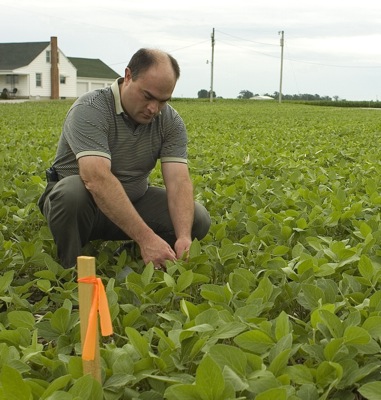Tuesday, June 26th, 2007
Sentinel plots provide early warning for soybean rust
Extension agents in Mercer and Auglaize counties keeping tabs on soybeans
By Nancy Allen

Photo by Mark Pummell/The Daily Standard
Todd Mangen, OSU Extension agent for Mercer County, checks soybean plants in a sentinel plot of soybeans on the Carmel Church Road farm of Brad Suhr. The sentinel plot program is designed to give agriculture officials early warning of Asian soybean rust and other plant diseases and insect pests.
Sentinel plots of soybeans meant to give local producers early warning of Asian soybean rust are growing in Mercer and Auglaize counties.
Mercer County OSU Extension agent Todd Mangen said he will soon begin taking leaf cuttings for testing from a 50-feet by 50-feet plot on the Carmel Church Road farm of Brad Suhr that was planted last May. This is Mercer County's first sentinel plot.
Auglaize County's sentinel plot is located five miles east of Wapakoneta at the northeast corner of Middle Pike and Townline-Lima Road on the farm of Jim and Sally Becher. This is the third year for a sentinel plot in that county.
Soybean rust is a fungal disease that reduces yields and raises production costs. It is caused by either of two fungal species and is spread primarily through windborne spores that can be transported long distances, a USDA Web site on the plant disease states.
"Once they start flowering, we will pull 100 leaves every seven to 10 days and send them to OARDC (Ohio Agricultural Research and Development Center) in Wooster for testing," Mangen said of the sentinel plot. "The purpose of the sentinel plot is to monitor and determine if rust is in the area and if it is, we can tell our producers to apply fungicide."
Fungicides have proven very effective in managing the disease, which was first confirmed in the United States in 1994 in Hawaii. Experts believe it came from somewhere in Asia, though they're not sure where, said Anne Dorrance, soybean extension pathologist at Ohio State University.
The symptoms of soybean rust begin on the lower leaves of the soybean plant as small lesions and irregularly shaped spots which turn tan to brown or reddish as the disease progresses.
The North Central Soybean Research Program, United Soybean Board, USDA and several other agencies have joined forces to do the sentinel plot program.
Two years ago, experts thought the disease may make it to Ohio, but it hasn't yet.
"The thing about rust is it moves on storm fronts. With us not getting a lot of rain, that will probably slow it down a bit," Mangen said. "But of course you always have wind, so it's a guessing game as to when it will make it here."
Auglaize County OSU Extension agent John Smith agreed, adding that this year's dry weather has kept his county's sentinel plot mostly free of insects and disease.
"We were expecting lots of soybean aphids this year, but we've seen none so far," Smith said. "We've seen some bean leaf beatle early on, but not much."
Mangen said contrary to what some believe, soybean rust can be managed effectively with commercial fungicides applied to plants at the right time. Soybean plants should not be sprayed with fungicide unless soybean rust has been confirmed, and if it has, soybeans should not be sprayed until they are in the reproductive (flowering) stage, a precursor to bean formation.
Mangen said he heard that some producers applied fungicide in Mercer County last year as a "just in case" measure, even though no rust had been detected in the county. He urged producers not to do this.
"If it never gets here, it's just a waste of money," he said.
There currently are roughly 40 sentinel plots throughout Ohio, mostly in the western part of the state, he said, including Auglaize, Darke, Shelby and Van Wert counties.
Soybean rust has been confirmed in southern states of the U.S., including Alabama, Florida, Louisiana, Georgia and Texas.
Anyone suspecting soybean rust in their fields in Ohio should contact their local county extension agent. The Mercer County OSU Extension office number is 419-586-2179.
Anne Dorrance , an Ohio State University plant pathologist and expert on Asian soybean rust, said the cards are stacked in favor of rust not making it to Ohio this year, but ag officials still have to wait and see. Dorrance is among the team heading up the sentinel plot concept and is on the cutting edge of soybean rust study.
"Currently there have been positive findings (of rust) in Florida and Louisiana and a report from Mexico and southern Texas, however this is nowhere near the innoculum (spores) needed to get a full, raging epidemic going that would hit us mid-season, which is what we're concerned about." she said
Go to the USDA's Web site at http://www.sbrusa.net or the OSU Extension Web site at http://ohioline.osu.edu/ac-fact/0048.html

